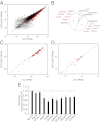Transcription factor Nurr1 maintains fiber integrity and nuclear-encoded mitochondrial gene expression in dopamine neurons
- PMID: 23341612
- PMCID: PMC3568335
- DOI: 10.1073/pnas.1221077110
Transcription factor Nurr1 maintains fiber integrity and nuclear-encoded mitochondrial gene expression in dopamine neurons
Abstract
Developmental transcription factors important in early neuron specification and differentiation often remain expressed in the adult brain. However, how these transcription factors function to mantain appropriate neuronal identities in adult neurons and how transcription factor dysregulation may contribute to disease remain largely unknown. The transcription factor Nurr1 has been associated with Parkinson's disease and is essential for the development of ventral midbrain dopamine (DA) neurons. We used conditional Nurr1 gene-targeted mice in which Nurr1 is ablated selectively in mature DA neurons by treatment with tamoxifen. We show that Nurr1 ablation results in a progressive pathology associated with reduced striatal DA, impaired motor behaviors, and dystrophic axons and dendrites. We used laser-microdissected DA neurons for RNA extraction and next-generation mRNA sequencing to identify Nurr1-regulated genes. This analysis revealed that Nurr1 functions mainly in transcriptional activation to regulate a battery of genes expressed in DA neurons. Importantly, nuclear-encoded mitochondrial genes were identified as the major functional category of Nurr1-regulated target genes. These studies indicate that Nurr1 has a key function in sustaining high respiratory function in these cells, and that Nurr1 ablation in mice recapitulates early features of Parkinson's disease.
Conflict of interest statement
The authors declare no conflict of interest.
Figures





References
-
- Graf T, Enver T. Forcing cells to change lineages. Nature. 2009;462(7273):587–594. - PubMed
-
- Holmberg J, Perlmann T. Maintaining differentiated cellular identity. Nat Rev Genet. 2012;13(6):429–439. - PubMed
-
- Hobert O. Regulation of terminal differentiation programs in the nervous system. Annu Rev Cell Dev Biol. 2011;27:681–696. - PubMed
-
- Wang Z, et al. Structure and function of Nurr1 identifies a class of ligand-independent nuclear receptors. Nature. 2003;423(6939):555–560. - PubMed
Publication types
MeSH terms
Substances
Associated data
- Actions
LinkOut - more resources
Full Text Sources
Other Literature Sources
Molecular Biology Databases

